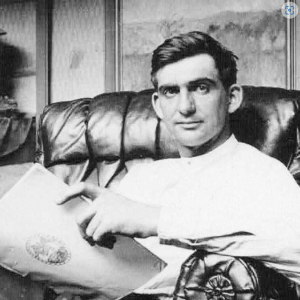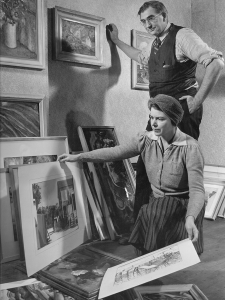

Biography
Gerrit Sinclair was born in 1890 in Grand Haven, Michigan, on the east shore of Lake Michigan. After a productive career as a regionalist painter and widely respected art teacher, he died in 1955 in Milwaukee, Wisconsin, directly across Lake Michigan on its western shore. The fact that Sinclair never moved very far from his birthplace is mirrored by the way in which his art retained a characteristic regional quiet.
Sinclair's art education came at the Art Institute of Chicago, where he developed his approach to an art that emphasized the "virtues of family, patriotism, hard work and the simple pleasure of daily life." He did travel around the world, enlisting in the Army Ambulance Corps in 1917 and serving in central Italy.
Following his service in World War I, he joined the Layton School of Art in Milwaukee as a founding member, teaching there until his retirement 1954. He spent a year abroad in Paris, but he never got caught up in the currents of modern art, remaining a staunch exemplar of American Scene painting.


Critical Analysis
Many of the Depression Era artists chafed under the constraints of government programs, which tended to emphasize regionalist art. But Sinclair, supremely comfortable in that genre, would have been happy to stick with the American Scene in his commission for the Section of Fine Arts. Interestingly, his composition for the Wausau, Wisconsin Post Office "Lumbering" departed from the style he adopted more commonly. "Lumbering" has an energy and muscularity that is absent from the majority of Sinclair's work.
Sinclair's other work is best described as placid. This is not a criticism, since it is clearly the tone to which he aspired. He largely avoided topics of industry or strife and focused on events within a peaceful and orderly society.
He was a technically accomplished painter, and his students include many outstanding Wisconsin artists.
Murals
- Wausau, Wisconsin - Federal Building Lofts: Lumbering
References
- 1930s Art by Gerrit Van Sinclair (Port Washington Voice).
- Gerrit Sinclair (David Barnett Gallery).
- Gerrit Sinclair (Gallery of Wisconsin Art).
- Gerrit Sinclair (Richard Norton Gallery).
- Michael D. Hall, Gerrit V. Sinclair (1890-1955). Richard Norton Gallery , Chicago, IL (2008).
- Janet Tracy, Gerrit V. Sinclair 1880-1955: A Retrospect, Resource Library Magazine August 22 (2002).